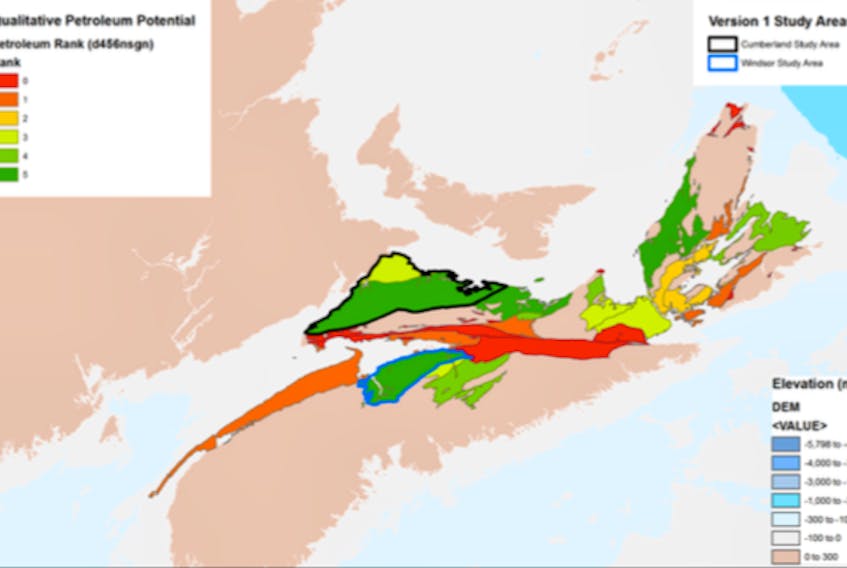WINDSOR, N.S. – An energy expert says they've made their 'best guess' when it comes to determining the amount of shale gas that could be recovered underneath Hants County if a moratorium on hydraulic fracturing was lifted.
In an interview with the Valley Journal-Advertiser, Sandy MacMullin, a professional engineer and executive director of the Petroleum Branch with the Nova Scotia Department of Energy, said the recent Onshore Atlas project, which highlights the shale gas potential in the province, is not a guarantee of what resources are waiting to be tapped.
“In the oil and gas industry we tend to use the word reserve when it's been found and is considered to be commercial,” MacMullin said.
“In the Atlas, we talk about potential or a potential reserve, which might be recoverable,” he continued.
“Our Atlas is saying we have 36 trillion cubic feet (TCF) of potential gas in place in two basins, of which the majority is expected to be in Hants County,” MacMullin said. “Our estimate is that seven of the 36 TCF is recoverable. I also have to say that 36 TCF is our best guess based on the data that we have.”
MacMullin said the department is confident that the numbers and techniques used for the Onshore Atlas Project by staff and outside consultants were done to an industry standard, with their own geologists and physicists working on the project to provide necessary data.
Despite that, he said uncertainty remains regarding how much potential reserve is actually available and how much is recoverable.
“It could be a lot less, it could be a lot more,” he said. “It’s our best guess based on the data we have today.”
The seven TCF that the department estimates to be recoverable would be equivalent to more than three Sable Offshore energy projects, he said.
- More stories on the Onshore Atlas Project
- Provincial PC leadership candidate wants fracking moratorium lifted, with caveats
- New data shows large shale gas potential in Hants County
- Editorial: Fracking moratorium must remain intact
Potential reserve
“The majority of the gas that we’ve projected is expected to be in what we call the Windsor-Kennetcook Basin, which is in Hants County,” he said. “The northern half of Hants County is what would be the attractive area. It’s sufficient to say that probably 30 of the 36 TCF is in Hants County, four and half of the six to seven TCF that’s recoverable is in Hants County.”
MacMullin said the value of the potentially recoverable gas, based on U.S. dollars, would be in the range of $10 to $20 billion in Hants County alone.
But, it’s not all isolated in one place or one well, it’s likely spread out over a large area geographic area.
“The gas in the sable project is in five very specific locations, whereas the numbers we’re providing is spread over the northern portion of Hants County,” he said. “We can’t tell you ‘this is exactly where you need to drill,’ it’s statistically where you’re more likely to see the resource.”
The study formally began in 2013, but he said geologists have been working on mapping mineral resources and onshore geology in the province for decades.
The study was originally planned to be completed in March 2017, but due to staffing issues, it was delayed until late 2017.
“What gave this a little more profile is that there is a hydraulic fracturing moratorium in shales,” he said. “What we needed to assess was how much of a resource potential would fall under that description? How much wouldn’t?”

MacMullin said the Onshore Atlas hasn’t lead to any policy changes when it comes to hydraulic fracturing, at least not yet.
“It’s my understanding and it’s been made pretty clear by the premier and the minister that there is no intention to change the legislation,” he said. “We’re working within the legislation.”
MacMullin said that the province remains committed to their goals of reducing greenhouse gas emissions and moving to a greener economy.
“We have to get cleaner and we have been on a process for some time now to get there,” he said. “It can’t be a cold turkey thing, we’re going to need to burn some coal for some time yet and do it in a responsible way.”
Fracking remains controversial
“There’s no shortage of viewpoints, and whether you believe that those people with those views are broadly educated or not, they have those views, and I think there’s lots of things people in society have opinions on that their knowledge can be quite extensive or otherwise,” he said. “What we’re looking at is a majority of the population that is quite fearful of high volume hydraulic fracturing in shale, so that’s why the government has taken its position that we see no reason to change the law that’s been put in place.”
He said that the fracking wastewater ponds in the Kennetcook area, which have been a thorn in that community’s side since 2007, were fully remediated as of November 2017.
“A lot of it was treated over the years, but then rain came in and filled the holes back up again,” he said. “In terms of concentration, it got less and less over time, but the volume didn’t change. But it’s been remediated to everyone’s satisfaction.”
He said they haven’t collected data on whether or not hydraulic fracturing in Nova Scotia could lead to earthquakes, as it has been reported to do in other provinces, including British Columbia.
“If some government down the road was going to lift the moratorium and wanted to get data on tremors, for example, (they could) but it’s not something we spend a lot of time thinking about,” he said.









